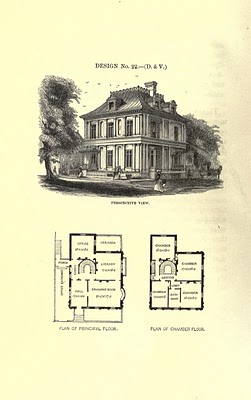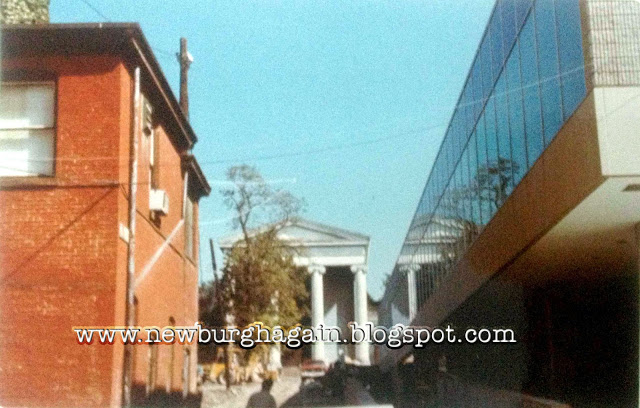Newburgh City Club (Culbert House)
Newburgh, NY

As described by the Calvert Vaux Preservation Alliance: The Newburgh City Club, originally the Culbert House, was designed by Vaux and A.J. Downing in 1851 – 52 during their all too brief working relationship. The house was designed for a prominent Newburgh doctor, William A.M. Culbert (design #22 entitled “Suburban House With Curved Roof” in Vaux’s book, Villas and Cottages), and was expanded after the Newburgh City Club acquired it in 1904. The building was restored in 1975 – 76 only to have its interior gutted by a suspicious fire in 1981. The City Club still sits today in front of the south end of the Newburgh Free Library. The exquisite concave roof is completely gone, as are the majority of the building’s exterior design elements, yet its basic structure appears to be sound and restorable. It is part of CVPA’s mission to see that this contributing building to Newburgh’s Montgomery – Grand – Liberty Streets Historic District is fully restored and an adaptive reuse found that will benefit the Newburgh community and its struggling economy.

From Villas and Cottages:
PICTURESQUE SQUARE HOUSE.
This house, which now belongs to a gentleman residing in Newburgh, was planned for another party in the first instance, and was partly executed with the idea that it was to be very simply and economically finished. It was commenced without any intention of constructing the dormer-windows, the projecting hoods, or the covered balcony over the lower bay, all of which, as may be seen on reference to the sketch, help materially to give individuality and completeness to the design. The main outline of the plan is a simple parallelogram, without any break in the walls, and the study may, therefore, be interesting to those who like a generally picturesque effect in a house, but who wish to avoid irregularities in the internal arrange
ment, or uneconomical projections in carrying up the brick-work. During the progress of the work the building changed hands, and came into the possession of its second owner, Mr. D. Moore, and in accordance with his instructions the design was improved in many important points. The additions already referred to were made, another bay-window was introduced, the roof to the veranda, also, was curved, and finished with a balustrade.
![[graphic][merged small][graphic][merged small]](http://books.google.com/books?id=SMAVdEFteWYC&pg=PA225&img=1&zoom=3&hl=en&q=&cds=1&sig=ACfU3U1T3kKIWiMyISqsO8k87iHUUHdQ6w&edge=0&edge=stretch&w=270&h=113&ci=162,962,672,279) The plan may be thus described: An inclosed wooden porch, shown to a larger scale at page 72, leads into the principal hall, which is paved with red, black, and buff encaustic tiles in a simple but effective star pattern. This hall communicates with the library, which is a handsomely-finished room, containing two book-cases recessed in the walls on one side, and a third arranged between the windows on the other side. The architrave mouldings of the doors, windows, and book-cases being boldly relieved, and so arranged that they may group together in several different combinations. The drawing-room extends the whole length of the house. The southern part was originally proposed for a bedroom, but when the property came into Mr. Moore’s possession it was connected with the parlor by an ornamental wooden arch, without folding doors. From this drawing-room the windows open on to a wide, spacious veranda, commanding an extensive view of the Hudson. In the staircase hall is a garden entrance, and a door to a small private room or office. The dining-room is in the basement, but the ground falls off so rapidly that the side of the room which looks out on to the ornamental garden, and the river beyond, is entirely out of ground, and communicates with a brick piazza supporting the veranda above. It has not, however, been thought necessary to give a separate plan of this floor, which contains kitchen and other offices, cellar, vaults, and furnace-room. Conveniently situated underneath the pavement of side-entrance is an outhouse and necessary, approached from the basement through a vinecovered veranda passage, and arranged on a similar plan to that already described in the opening chapter, and in the description of Mr. “Warren’s house. Mr. Moore’s house was, however, the first in which this plan was tried, and it was while endeavoring to overcome the difficulties suggested by his needs that the idea occurred to me. The filling up and grading about the house was thus made more satisfactory, and the outbuildings were entirely concealed from view, which could not, in any reasonable time, have been done by trees or evergreens on account of the continuous fall in the ground, which made it necessary that the principal rooms and veranda should look down on to the lawns and garden ground surrounding the house.
The plan may be thus described: An inclosed wooden porch, shown to a larger scale at page 72, leads into the principal hall, which is paved with red, black, and buff encaustic tiles in a simple but effective star pattern. This hall communicates with the library, which is a handsomely-finished room, containing two book-cases recessed in the walls on one side, and a third arranged between the windows on the other side. The architrave mouldings of the doors, windows, and book-cases being boldly relieved, and so arranged that they may group together in several different combinations. The drawing-room extends the whole length of the house. The southern part was originally proposed for a bedroom, but when the property came into Mr. Moore’s possession it was connected with the parlor by an ornamental wooden arch, without folding doors. From this drawing-room the windows open on to a wide, spacious veranda, commanding an extensive view of the Hudson. In the staircase hall is a garden entrance, and a door to a small private room or office. The dining-room is in the basement, but the ground falls off so rapidly that the side of the room which looks out on to the ornamental garden, and the river beyond, is entirely out of ground, and communicates with a brick piazza supporting the veranda above. It has not, however, been thought necessary to give a separate plan of this floor, which contains kitchen and other offices, cellar, vaults, and furnace-room. Conveniently situated underneath the pavement of side-entrance is an outhouse and necessary, approached from the basement through a vinecovered veranda passage, and arranged on a similar plan to that already described in the opening chapter, and in the description of Mr. “Warren’s house. Mr. Moore’s house was, however, the first in which this plan was tried, and it was while endeavoring to overcome the difficulties suggested by his needs that the idea occurred to me. The filling up and grading about the house was thus made more satisfactory, and the outbuildings were entirely concealed from view, which could not, in any reasonable time, have been done by trees or evergreens on account of the continuous fall in the ground, which made it necessary that the principal rooms and veranda should look down on to the lawns and garden ground surrounding the house.
The chamber plan will be found to contain four bedrooms, with a linen-room, bath-room, and watercloset, all easy of access, but planned with a special regard to privacy. An open and airy stairway to the attic leads into a roomy, well-lighted upper hall, communicating with four large bedrooms and a storeroom. Above this again is a well-ventilated garret four or five feet high, that affords convenient stowage for trunks, and furnishes a complete shield from the heat and cold. The attic rooms in this house are as convenient, and almost as agreeable, as the principal bedchambers below them ; and as they naturally command a more extensive view than can be obtained from the rest of the house, they have this one great advantage over the other rooms. A reference to the plan of roofs will show how, by the arrangement of the flat on the top, the whole composition is simply treated, so as to offer as little resting-place as possible.







